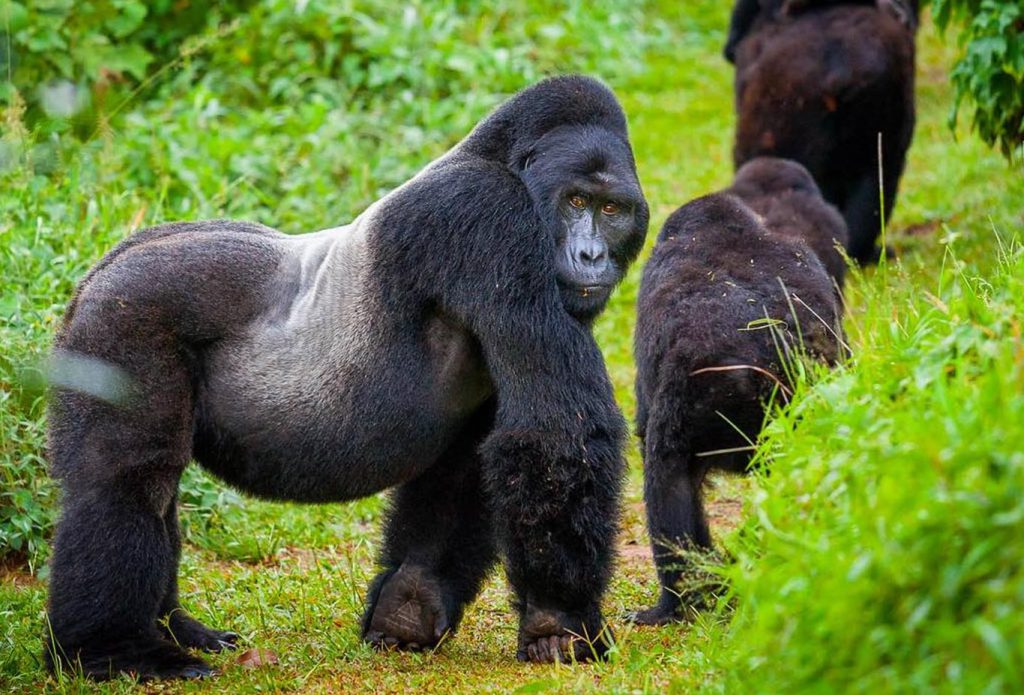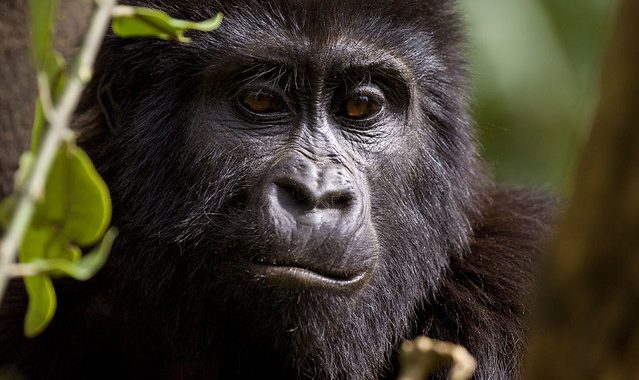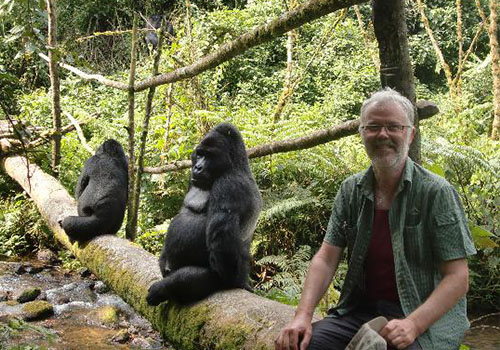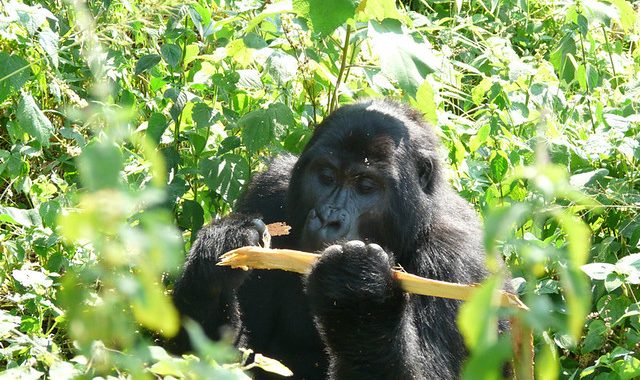The cost for Uganda gorilla trekking permits is $700 effective 1st July 2020. The increase…
Budget Gorilla Trekking Deals in Uganda 2024-2025
Budget Gorilla trekking Deals in Uganda, Budget Gorilla Safaris in Uganda, Affordable gorilla trekking tours Uganda.
Where To see Gorillas in Africa – Uganda and Rwanda.
Uganda is one of the best destinations for Gorilla trekking. Budget Gorilla trekking Deals in Uganda, allow you see the mountain Gorillas in their natural habitat at a relatively cheaper cost than Rwanda.
Where can you find gorillas in Africa? Gorillas are undoubtedly the most intriguing of all wild primates. They are the more strong and larger beasts, yet they are also incredibly kind. Gorillas are unique because they act and have more than 97% of our genetic makeup as humans. Even though chimpanzees are smarter and more cunning than gorillas, they are more violent and disorderly.
 Generally speaking, gorillas are charming, wiser, and charitable. The western and eastern gorillas are the two primary species of gorillas, both of which are entirely native to Africa. There are two subspecies of western gorillas: the Cross River Gorilla and the Western Lowland Gorilla. Mountain gorillas and eastern lowland gorillas (Grauer’s gorilla) are the two subspecies of gorillas found in the eastern hemisphere. With a total population of approximately 250,000, the western lowland gorilla is the most prevalent.
Generally speaking, gorillas are charming, wiser, and charitable. The western and eastern gorillas are the two primary species of gorillas, both of which are entirely native to Africa. There are two subspecies of western gorillas: the Cross River Gorilla and the Western Lowland Gorilla. Mountain gorillas and eastern lowland gorillas (Grauer’s gorilla) are the two subspecies of gorillas found in the eastern hemisphere. With a total population of approximately 250,000, the western lowland gorilla is the most prevalent.
According to scientists, the ice age is when western and eastern gorillas split apart. Rain-forests shrank into smaller forests that were separated by savanna due to the cold and ice. The rain forest returned to the tropics after the ice age. Since the western and eastern gorillas had been separated for too long, they had begun to develop physically and genetically in different ways. All gorilla species have one characteristic in common despite some variances. They have larger hands, larger forearms, and broad shoulders and chests. Their nostrils are huge and prominent, and their face is hairless and has close-set eyes. The eastern gorillas have longer, darker fur than the western gorillas and are larger. Male gorillas can weigh up to 200 kg as adults.
Gorillas are largely vegetarian and eat fruits, tree stems/bark, bamboo shoots, and even insects. The dominating Silverback is the leader of the rather stable groups where gorillas dwell. Gorilla groups can have anywhere from two to fifty individuals. Where to eat and rest is decided by the dominant male. He keeps a close eye on everyone in the troop and will defend his family against intruders such as other silverback gorillas, other animals, or people. Until he passes away or is replaced by a stronger male from the same group or one from another, the dominant male rules. Males reach sexual maturity at the age of 15, and the dominant silverback in a gorilla community has complete control over mating rituals.
Once they reach maturity, females typically leave a group to join a single male or other groups. Although females reach sexual maturity at age 8, they don’t begin reproducing until much later. Rare instances of females giving birth inside their own group have been observed, particularly in cross-river gorillas. In a woman’s lifetime, she will give birth to roughly four children. In the wild, gorillas can live up to 40 years of age, and they can reach 50 in captivity.
Western lowland gorillas are the most common and populous, with about 250,000 individuals. They endure the harshest treatment as a result of their frequent interactions with people. The eastern lowland gorillas, which number around 7,000, follow them in population. Although the number of mountain gorillas may have increased by the biggest proportion, their entire population, at roughly 1,000, is one of the lowest. The Cross River gorillas in Nigeria and Cameroon can be found at the bottom of the curve. Only 250 Cross river gorillas remain in the wild today.
Over the past few decades, there has been a considerable decline in the gorilla population as a whole. Due to habitat loss brought on by logging and mineral extraction, disease, war, and instability, the majority of the species are now classified as severely endangered or threatened. A cooperative effort between governments and animal conservation organizations is essential to preventing the extinction of these big apes. Stopping the illegal trade in newborn gorillas, halting forest encroachment, and outlawing poaching are three ways to conserve primates. To assist raise money and develop shared responsibility, local and worldwide communities should be involved in conservation activities. Additionally, for greater effectiveness, all conservation initiatives for gorillas must be integrated into larger programs for the protection of wildlife.
Where do gorillas live in Africa?
Where can I find gorillas in the wild? The forests of Angola, Cameroon, Central African Republic, Democratic Republic of the Congo, Equatorial Guinea, Gabon, Nigeria, Rwanda, and Uganda are home to wild gorillas. Although the majority of visitors travel to Uganda and Rwanda to track gorillas, West Africa has even more exhilarating adventures for those who adore primates. Amazing biodiversity will be yours if you can put up with the discomfort, uncertainty, and lengthy journey times in some of the West African nations. We’ll now talk about the several nations where gorillas can be found.
Where to see gorillas in Rwanda.
One of the best sites to view gorillas in the wild is Rwanda. About 30% of the mountain gorillas left in the world are found in Rwanda. The Volcanoes National Park of Rwanda is home to all of Rwanda’s gorilla species. The renowned primatologist Dian Fossey set up shop here in the 1960s to investigate the behavior of these magnificent animals. Volcanoes National Park’s gorilla trekking is particularly well-liked and draws tens of thousands of tourists there each year. Currently, Rwanda is home to ten habituated mountain gorilla populations.
The easiest location in the world to see mountain gorillas is regarded as Rwanda. Because of its well-developed tourism infrastructure and comparably more competent services, Rwanda is the ideal place to visit gorillas. Over 99% of people visiting Rwanda will see gorillas. Rwanda has the most expensive gorilla licenses, at $1500 each.
Where to see gorillas in Uganda?
One of the best sites to watch mountain gorillas is in Uganda. Two national parks in Uganda, Bwindi Impenetrable National Park and Mgahinga National Park, are home to half of the world’s mountain gorilla population. There is only one habituated gorilla group in Mgahinga National Park, compared to 17 in Bwindi. Mountain gorillas prefer lower terrain in Bwindi, while those in Mgahinga reside in relatively high heights. Many of the gorilla groups in Uganda are still in the wild due to the huge population. Additionally unique is the fact that Uganda is the only nation where one can participate in a gorilla habituation experience.
In contrast to normal gorilla trekking, which allows visitors to spend only one hour with a gorilla group, this exclusive experience allows visitors to observe the primates for almost four hours. Additionally, visitors can engage in a wider range of animals and activities in Uganda after viewing the gorillas. Although Uganda is undoubtedly the best place to go gorilla trekking, the government there is not as forceful in its promotion of the practice as it is in Rwanda. Some tourists are put off by the lengthy driving distance from Bwindi or Mgahinga to Kampala, the capital, or Entebbe.
Many choose to cross into Uganda rather than drive the lengthy journey from Rwanda. In Uganda, there is a very high probability of witnessing mountain gorillas (around 99%). Because gorilla permits in Uganda are so expensive ($700), it’s a great place to go gorilla trekking on a budget.
Where to see gorillas in Congo.
One of the African nations with possibly the highest tourism potential has frequently been off-limits to the globe because to civil conflict and political unrest. Only the Democratic Republic of the Congo is home to three of the gorilla subspecies. The Virunga National Park offers opportunities to see mountain gorillas. Western lowland gorillas live in the Madiakoko Mountains in the country’s far west, whereas eastern lowland gorillas live in Kahuzi Biega National Park. The only national parks where travelers can currently see gorillas are Virunga and Kahuzi Biega due to the unrest in the country’s eastern region.
Since they frequently travel to and from Angola, the odds of spotting western lowland gorillas are slim. In the Congo, gorilla permits cost $400.
Seeing Wild gorillas in West Africa.
Cameroon.
One of the nations in West Africa that is home to western gorillas is Cameroon. Western lowland gorillas and Cross River gorillas can be found in this nation. Gorillas from the Cross River region reside on the Nigeria–Cameroon border. Of all the gorilla subspecies, they are the most seriously endangered. In fact, until quite recently, it was believed that they had gone extinct. Since there is no habituated group, visitors cannot yet visit the Cross River gorillas. The lone Cross River gorilla living in captivity can be found at the Limbe Wildlife Centre, which also cares for orphaned western lowland gorillas.
The Campo-Ma’an National Park is home to the western lowland gorillas of Cameroon. The possibility of spotting primates while visiting the national park is less than 70%. The Mefou National Park is the ideal place to see rescued orphaned lowland gorillas.
Nigeria:
The odds of encountering Cross River gorillas in the wild are quite limited because they are not habituated, despite the government of Nigeria making significant investments in the industry. Additionally, Cross River gorillas have a reputation for being more hostile toward people. Given that there are less than 300 primates left in the wild, only researchers and conservationists are allowed to see them. Even if visitors were permitted entry, it would be quite challenging to locate the primates quickly. They are dispersed in a region that is 2,900 square miles in size and includes parts of Mbe Mountain and Afi Mountain as well as the Cross River National Park.
Central African Republic:
One of the finest sites to locate western lowland gorillas is the Central African Republic. A gorilla study and habituation initiative run by the Wild Wildlife Fund (WWF) has so far been successful in acclimating one group at the Dzanga-Ndoki National Park. There is a decent chance of seeing gorillas, though it can be difficult to get excellent pictures in the dark, dense forest.
Republic of Congo or Congo Brazaville:
West African lowland gorillas can be seen most easily in the Republic of Congo. Only a small portion of the nearly 22,000 gorillas present in Odzala National Park—two habituated gorilla groups are accessible to tourists. The best method for spotting them is to wait for them to emerge in open clearings (known as
Bai) while hiding away or remaining in concealed enclosures. A hundred people have been seen by the Wildlife Conservation Society at Mbeli Bai, a well-known open area, over a ten-year period.
In addition to these forest clearings, gorilla families can often be seen foraging in marshes and swamps with other animals (buffaloes, swamp antelopes, and elephants) for water plants. The Léfini Reserve is another location in Congo Brazaville where you can see western lowland gorillas. Due to the reserve’s location on an island, tourists can view the gorillas from a boat. Wherever you decide to go for gorillas in the Republic of Congo, you may expect to find un spoilt wildness. The price of a gorilla permit at Odzala National Park is $355 per person.
Gabon:
Gabon is a wonderful location for those who love animals because it has over 12 national parks to its name. Unfortunately, despite the fact that most of the national parks in Gabon feature western lowland gorillas, gorilla trekking is not yet extensively developed in that country. One of the greatest populations of gorillas in Africa can be found in Moukalaba-Doudou National Park. The sheer number of primates in the park makes it unique. To enable visitors to see these primates, an ecotourism initiative was developed. Now, visitors can travel on foot deep into the jungle to search for the primates. In Lopé National Park, there was also a habituation program for Western lowland gorillas, although it was unsuccessful. In Lopé National Park, the only method to observe gorillas is on a safari to see other animals. Western lowland gorillas thrive at Loango National Park, which is also a fantastic environment. It is a distinctive national park that stretches all the way to the Atlantic Ocean and has a rich biodiversity. Visitors can witness dolphins, whales, and hippos along the ocean shoreline or venture into the forest to observe chimpanzees, forest elephants, and gorillas. It offers a combination of forest and sea life.
Equatorial Guinea:
One of the final refuges for the western lowland gorilla is Equatorial Guinea. The primates can be found at Monte Alen National Park, but the gorilla tourism industry is still in its infancy, and the park lacks any habituated gorilla groups despite having a fairly dense canopy of trees. The good news is that daily walks with tourists into the jungle are now led by a few trained locals. You should arrive in the region and speak with the locals about how to see gorillas if you’re the daring sort and want to experience something genuinely unique.
Angola:
Angola is also home to western lowland gorillas. They only have one home, the Cabinda enclave near the River Congo, in the northern region of the nation. The chances of seeing gorillas are currently low as we write this post, so if you’re thinking about going to view them in Angola, you should be aware that the industry is not well-organized for gorilla tourism.
Contact us to book your Budget Gorilla trekking Deals in Uganda



